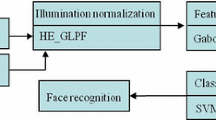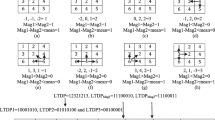Abstract
The face recognition under the uncontrolled conditions is a widely debated research topic since from last decade due to technology advancement and the emergence of face recognition applications. The uncontrolled conditions such as illumination and pose variations, light intensity variations, etc. lead the poor face recognition performances. The extraction of invariant features in the presence of illumination variations is a difficult task. The variations of light intensity in face images effective in case of large-scale features that are truncated in recent techniques to release clarification mandatory specialties. But the loss of salient features during the release method of small-scale specialties leads to poor face identification performance. In this paper, the robust face descriptor method designed to discuss the challenges of face identification following uncontrolled environments. The proposed framework of variations aware geometric moments and histogram features normalization (VGHN) designed to handle the variations in illumination, pose, and light intensity of face images. In pre-processing, the difference of Gaussian filtering method applied to smooth these variations of each face image. To bridge the semantic recess within the spatial learning and histogram description, we build the face descriptor using the kirsch compass masks to extract the edge directional patterns from the pre-processed image. From each directional pattern, we extracted the variations aware and meaningful features using Geometric moments. The histogram features then removed from the pre-prepared face image. The rich set of features representation of face image has performed by the fusion of geometric moments and histogram features. The artificial neural network and support vector machine used at the end for face recognition and classification purpose. The representation of the VGHN system estimated working various research face datasets. The outcomes show that VGHN was able to improve the robustness compared to existing methods.








Similar content being viewed by others
References
Meher SS, Maben P (2014). Face recognition and facial expression identification using PCA. In: 2014 IEEE international advance computing conference (IACC). https://doi.org/10.1109/iadcc.2014.6779478
Samad R, Sawada H (2011) Edge-based facial feature extraction using gabor wavelet and convolution filters
Kansal S (2013) Human facial expression recognition using gabor filter bank with minimum number of feature vectors. J Inf Syst. https://doi.org/10.5120/ijais13-450971
Thai LH, Nguyen DTN, Tran SH (2011) A facial expression classification system integrating canny, principal component analysis and artificial neural network. ar**v: 1111.4052
Abdulrahman M, Gwadabe TR, Abdu FJ, Eleyan A (2014) Gabor wavelet transform based facial expression recognition using PCA and LBP. In: 2014 22nd signal processing and communications applications conference (SIU). https://doi.org/10.1109/siu.2014.6830717
Sobia MC, Brindha V, Abudhahir A (2014). Facial expression recognition using PCA based interface for wheelchair. In: 2014 international conference on electronics and communication systems (ICECS). https://doi.org/10.1109/ecs.2014.6892592
Poon B, Ashraful Amin M, Yan H (2011) Performance evaluation and comparison of PCA based human face recognition methods for distorted images. Int J Mach Learn Cybern 2(4):245–259. https://doi.org/10.1007/s13042-011-0023-2
Rahulamathavan Y, Phan RC-W, Chambers JA, Parish DJ (2013) Facial expression recognition in the encrypted domain based on local fisher discriminant analysis. IEEE Trans Affect Comput 4(1):83–92. https://doi.org/10.1109/t-affc.2012.33
Sarawagi V, Arya KV (2013) Automatic facial expression recognition for image sequences. In: 2013 sixth international conference on contemporary computing (IC3). https://doi.org/10.1109/ic3.2013.6612205
Chao W-L, Liu J-Z, Ding J-J, Wu PO-H (2013) Facial expression recognition using expression-specific local binary patterns and layer demising mechanism. In: Information, communications and signal Processing, 2013 9th international conference on. IEEE, 2013, pp 1–5
Anil J, Suresh LP (2016) Literature survey on face and face expression recognition. In: 2016 international conference on circuit, power and computing technologies (ICCPCT). https://doi.org/10.1109/iccpct.2016.7530173
Ou J, Bai X-B, Pei Y, Ma L, Liu W (2010) Automatic facial expression recognition using gabor filter and expression analysis. In: 2010 second international conference on computer modeling and simulation. https://doi.org/10.1109/iccms.2010.45
Goyani M, Gohil G, Chaudhari A (2011) Robust face recognition in low dimensional subspace using reconstructive and discriminative features. In: 2011 international conference on communication systems and network technologies. https://doi.org/10.1109/csnt.2011.80
Kim D-J, Lee S-H, Sohn M-K, Kim B, Kim H (2013) Face recognition in unconstrained environments. In: 2013 IEEE international conference on consumer electronics (ICCE). https://doi.org/10.1109/icce.2013.6486832
Tistarelli M, Sun Y, Poh N (2014) On the use of discriminative cohort score normalization for unconstrained face recognition. IEEE Trans Inf Forensics Secur 9(12):2063–2075. https://doi.org/10.1109/tifs.2014.2362007
Kim H-I, Lee SH, Ro YM (2015). Face image assessment learned with objective and relative face image qualities for improved face recognition. In: 2015 IEEE international conference on image processing (ICIP). https://doi.org/10.1109/icip.2015.7351562
Anubha Pearline S, Hemalatha M (2016) Face recognition under varying blur, illumination, and expression in an unconstrained environment. Spec Issue Int J Comput Sci Inf Secur
Weng R, Lu J, Tan Y-P (2016) Robust point set matching for partial face recognition. IEEE Trans Image Process 25(3):1163–1176. https://doi.org/10.1109/tip.2016.2515987
Ding C, Choi J, Tao D, Davis LS (2016) Multi-directional multi-level dual-cross patterns for robust face recognition. IEEE Trans Pattern Anal Mach Intell 38(3):518–531. https://doi.org/10.1109/tpami.2015.2462338
Almudhahka NY, Nixon MS, Hare JS (2018) Semantic face signatures: recognizing and retrieving faces by verbal descriptions. IEEE Trans Inf Forensics Secur 13(3):706–716. https://doi.org/10.1109/tifs.2017.2765519
Phankokkruad M, Jaturawat P (2017). Influence of facial expression and viewpoint variations on face recognition accuracy by different face recognition algorithms. In: 2017 18th IEEE/ACIS international conference on software engineering, artificial intelligence, networking and parallel/distributed computing (SNPD). https://doi.org/10.1109/snpd.2017.8022727
Huang W, Yin H (2017) Robust face recognition with structural binary gradient patterns. Pattern Recogn 68:126–140. https://doi.org/10.1016/j.patcog.2017.03.010
Jian Z, Chao Z, Shunli Z, Tingting LU, Weiwen SU, Jian J (2018) Pre-detection and dual-dictionary sparse representation based face recognition algorithm in non-sufficient training samples. J Syst Eng Electron 29:196–202. https://doi.org/10.21629/JSEE.2018.01.20
Srisawasd W, Wongthanavasu S (2018) Face recognition in unconstrained environment. In: 2018 15th international joint conference on computer science and software engineering (JCSSE)
Oloyede MO, Hancke GP, Myburgh HC (2018) Improving face recognition systems using a new image enhancement technique, hybrid features and the convolutional neural network. IEEE Access. https://doi.org/10.1109/access.2018.2883748
Lu J, Liong VE, Zhou J (2018) Simultaneous local binary feature learning and encoding for homogeneous and heterogeneous face recognition. IEEE Trans Pattern Anal Mach Intell 40(8):1979–1993
Duan Y, Lu J, Feng J, Zhou J (2018) Context-aware local binary feature learning for face recognition. IEEE Trans Pattern Anal Mach Intell 40(5):1139–1153
Agrawal AK, Singh YN (2018) Face recognition system in unconstrained environment through convolution neural network. In: 2018 fifth international conference on parallel, distributed and grid computing (PDGC)
He L, Li H, Zhang Q, Sun Z (2018) Dynamic feature matching for partial face recognition. IEEE Trans Image Process 28(2):791–802. https://doi.org/10.1109/tip.2018.2870946
Gaston J, Ming J, Crookes D (2018) Matching larger image areas for unconstrained face identification. IEEE Trans Cybern 49(8):3191–3202. https://doi.org/10.1109/tcyb.2018.2846579
Mahmood A, Hussain S, Iqbal K, Elkilani WS (2019) Recognition of facial expressions under varying conditions using dual-feature fusion. Math Probl Eng 2019:1–12
Yadav J, Rajpal N, Mehta R (2019) An Improved illumination normalization and robust feature extraction technique for face recognition under varying illuminations. Arab J Sci Eng. https://doi.org/10.1007/s13369-019-03729-6
Huang GB, Manu R, Tamara B, Erik L-M (2007) Labeled faces in the wild: a database for studying face recognition in unconstrained environments. Technical report, technical report 07-49, University of Massachusetts, Amherst, 2007
Gao W, Cao Bo, Shan S, Chen X, Zhou D, Zhang X, Zhao D (2008) The CAS-PEAL large-scale Chinese face database and baseline evaluations. Syst Man Cybern Part A Syst Hum IEEE Trans 38:149–161. https://doi.org/10.1109/TSMCA.2007.909557
Mahajan HB, Badarla A, Junnarkar AA (2020) CL-IoT: cross-layer Internet of Things protocol for intelligent manufacturing of smart farming. J Ambient Intell Humaniz Comput. https://doi.org/10.1007/s12652-020-02502-0
Mahajan HB, Badarla A (2018) Application of Internet of things for smart precision farming: solutions and challenges. Int J Adv Sci Technol 2018:37–45
Mahajan HB, Badarla A (2019) Experimental analysis of recent clustering algorithms for wireless sensor network: application of iot based smart precision farming. J Adv Res Dyn Control Syst. https://doi.org/10.5373/JARDCS/V11I9/20193162
Mahajan HB, Badarla A (2020) Detecting HTTP vulnerabilities in IoT-based precision farming connected with cloud environment using artificial intelligence. Int J Adv Sci Technol 29(3):214–226
Othman NA, Aydin I (2018) A face recognition method in the Internet of Things for security applications in smart homes and cities. In: 2018 6th international Istanbul smart grids and cities congress and fair (ICSG). https://doi.org/10.1109/sgcf.2018.8408934
Aydin I, Othman NA (2017) A new IoT combined face detection of people by using computer vision for security application. In: 2017 international artificial intelligence and data processing symposium (IDAP). https://doi.org/10.1109/idap.2017.8090171
Funding
No Funding.
Conflict of ınterest
All authors declares that they has no conflict of interest.
Author information
Authors and Affiliations
Ethics declarations
Ethical approval
This article does not contain any studies with human participants performed by any of the authors.
Rights and permissions
About this article
Cite this article
Gangonda, S.S., Patavardhan, P.P. & Karande, K.J. VGHN: variations aware geometric moments and histogram features normalization for robust uncontrolled face recognition. Int. j. inf. tecnol. 14, 1823–1834 (2022). https://doi.org/10.1007/s41870-021-00703-0
Received:
Accepted:
Published:
Issue Date:
DOI: https://doi.org/10.1007/s41870-021-00703-0




